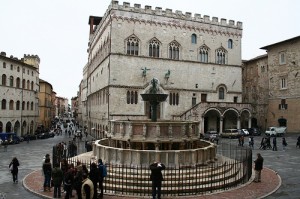Posts Tagged ‘amanda knox’
Amanda Knox Conviction: Motivazioni della Sentenza
 So far this week, we’ve been through the alleged anti-American bias and so-called media circus in the Amanda Knox murder case.
So far this week, we’ve been through the alleged anti-American bias and so-called media circus in the Amanda Knox murder case.
Quick recap: While it seems many (not all) Knox supporters have backed off the anti-Americanism claim, many still don’t believe the experiences of those of us who live in Italy regarding media coverage. I don’t know why I (and other Americans living in Italy who commented on the post of their own free will) would have any motivation to lie about how much average Italians followed this case in our experience, but there you have it.
My final words on that: Yes, this was a big news story when it broke — the murder of a young girl always is — and it got bigger because of the international angle, making it one of the top stories to come of out of Italy in many years (mostly because let’s be honest — the world normally doesn’t care what happens in Italy). But as far as what average Italians were talking about and paying attention to, this just wasn’t on the radar. I’m sorry if that ruins your image of our morning cappuccino chats, but it’s true.
One thing before we move on regarding comments, though: thank you to everyone who stayed on-topic and gave their viewpoints on the last post. Much appreciated. And to those who commented with obviously false email addresses, you’re spammers to me, so that’s where your comments went. Blatant disregard of my rules will also send your comment to the rubbish bin.
Moving on…
The So-Called Conviction Based on Nothing
I was in in the United States when the Knox and Sollecito verdicts were announced. Following the announcement, I watched as some American commentators trashed the entire Italian criminal justice system because an innocent American girl was railroaded and just convicted on no evidence and all of Italy should be ashamed of itself and harumph! *crosses arms in indignation*
It was a well-crafted and well-executed play on emotions, but unfortunately not entirely based in reality. There was and is evidence on which the court based its decision. In fact, the court has since written it out for everyone to read — in the 400+ pages of the “motivazioni della sentenza,” which we’ll get to in a bit.
Before I get into what is in the decision, let me lay down some disclaimers about this post:
 1. My goal here is mostly to provide those who haven’t been following the case or who haven’t been privy to what is contained in the sentencing report because they don’t read Italian an idea of what the Italian court believed and on what it based Knox’s conviction. From what I’ve read, particularly in the American press, the impression has been given that Knox was convicted based on her behavior and nothing more. This post is to clarify that the factfinders had more before them than just Knox’s behavior.
1. My goal here is mostly to provide those who haven’t been following the case or who haven’t been privy to what is contained in the sentencing report because they don’t read Italian an idea of what the Italian court believed and on what it based Knox’s conviction. From what I’ve read, particularly in the American press, the impression has been given that Knox was convicted based on her behavior and nothing more. This post is to clarify that the factfinders had more before them than just Knox’s behavior.
2. What I am including below is my personal translation of what I consider to be the major pieces of evidence on which Amanda Knox was convicted; there is obviously *much* more to the report, including various theories as to why Knox and Sollecito acted the way they did at different times. Some of those scenarios undoubtedly weighed more heavily into the decision than others (and it’s certainly personal opinion as to whether their scenarios make sense), but I’m focusing on physical evidence and eyewitness testimony, because, again, I don’t think they have been widely reported in English-speaking media.
In other words, I’m really not writing this post for those of you who live and breathe the case, as I’m sure those of you who disagree with the decision have an argument against every piece of evidence below — which by the way is entirely normal in a criminal trial.
3. I’m not addressing the evidence against Raffaele Sollecito or the case against Rudy Guede. This is not an indication that I think either or both of them was rightfully or wrongfully convicted — I’m just not covering it here. They certainly deserve their own posts, but I’m not the one to write them, at least not now.
4. This post will present what the judges wrote. Period. Whether or not you agree with the findings of the court is another matter entirely, and something many of you touched on in your comments throughout the week. You’re likely to get into that again in comments, but I’m not going to be commenting on it.
5. Whether or not I personally would have made the same findings of fact as the court did, I can’t say. In fact, I can’t know because I haven’t read the trial transcripts or have any indication of what witnesses sounded like, etc. I’m sorry I won’t take for granted what “journalists” have written about what went on in court. I just don’t trust either “side” with that information.
 6. Even taking as true every finding of fact by this court, whether or not I personally would have voted to convict Amanda Knox based on the evidence the court accepted is not in discussion — and this is closely related to the previous point.
6. Even taking as true every finding of fact by this court, whether or not I personally would have voted to convict Amanda Knox based on the evidence the court accepted is not in discussion — and this is closely related to the previous point.
Without having access to trial records and transcripts, I simply don’t feel like I can make an adequate judgment about what I would have done in their shoes. I could, with transcripts and previous motions and all that fun stuff, take a position on what I’d find on appeal — but I don’t have them, so I won’t.
Once upon a time, I used to be an appellate law clerk who reviewed trial court decisions in order to offer my thoughts to the judge under whom I worked, and trust me, the trial court’s opinion was *never* enough to go by. Related to this point, remember in your reading of my very brief summary of the motivazioni, what the report is: it is the trial court defending its decision. It doesn’t necessarily mean the judges are right, and although the court has balanced the evidence, the way it presents is findings is partial to the way the judges believed things happened — entirely normal.
7. The motivazioni della sentenza isn’t officially translated into English yet, but keep an eye out on my Facebook page and Twitter, and I’ll let you know if/when it’s released. In the meantime, if anyone wants a copy of the report in Italian, you can download it here (this is a tip from a reader; I have not downloaded from there and can’t find where I did get it from. If you want a copy from me, just be in touch). If I have messed up any page numbers, please let me know as well; I just haven’t had the time to triple- and quadruple-check things like I would like.
Now, the motivazioni.
The Alibi
The court didn’t believe Knox and Sollecito’s joint alibi; as most of you probably know, both changed their stories on some points, but the important parts of the alibi include the following: they watched a movie on the computer, had a late dinner (even as late as 11 p.m.), were at Sollecito’s apartment the entire evening of the murder, and slept in until about 10 a.m. the following morning.
The court found the following evidence credible:
- Sollecito’s father called him at 8:42 p.m. the evening of the murder, and at that point a water pipe under the sink was already broken while the dishes were being washed; the court concludes this means they had already eaten dinner and were washing up at that time, debunking the “late dinner” contention (p. 69).
- Sollecito’s computer was last used at 9:10 p.m. meaning that there is no further proof that the couple was in Sollecito’s apartment after that time (p. 68).
- An eyewitness testified he saw the couple outside near a basketball court at around 9:30 p.m. until sometime around 11 or 11:30 p.m., but they were gone by midnight (pp. 69-71).
- Computer data shows that Sollecito’s computer was turned on at 5:32 a.m. and music was played for about a half hour (p. 73).
- Sollecito’s cell phone was turned on at 6:02 a.m. at which time he received an SMS that his father had sent the previous evening at 11:14 p.m. (p. 73).
- An eyewitness identified a girl who matched Knox’s description as waiting outside of his “generi alimentari” store (sells everything from food to cleaning and personal hygiene products) to open at 7:45 a.m. the following morning; he didn’t remember what, if anything, this girl bought, but he did say he saw her headed in the direction of where Knox and Kercher lived (pp. 74-75).
- Sollecito’s father called and spoke to Sollecito at 9:30 a.m.; this phone call was never mentioned by Knox in her statements, which the court concluded to mean she didn’t know about the call because she wasn’t in Sollecito’s apartment at the time (p. 74).
Based on this evidence accepted by the court, they found that neither Knox nor Sollecito were truthful about their whereabouts the evening of the murder and the morning after.
The Forensics
The court turned to forensics, and accepted the following into evidence:
- Three separate samples found in the small bathroom that showed Kercher’s and Knox’s DNA mixed, all that tested positive for human blood (pp. 198, 204); these were located in a sink, around the drain of a bidet, and on a Q-tip container on the sink. Two experts maintained that the stains in the sink and bidet appeared to be diluted blood and made of a single trace based on their shape (rising and falling together) (pp. 301-02).
- Several samples taken from the small bathroom showed Kercher’s blood not mixed with anyone else’s DNA matter (pp. 198, 204); one of them was on the light switch and another on a bathmat, which the court concluded meant someone entered the bathroom with Kercher’s blood on him or her (p. 300).
- A sample that showed a genetic profile mix of Knox and Kercher in the bedroom of one of the Italian roommates (p. 200) — the room that also had a broken window.
- Also in the Italian roommate’s room, a footprint uncovered with luminol toward the entrance of the room that resulted in a genetic profile of Knox and Kercher mixed (pp. 205-06).
- A footprint in the hallway leading out of the Italian roommate’s room that had been uncovered by luminol with the genetic profile of Knox (p. 206).
- In sum: 10 samples in the house that included Knox’s DNA; five that were mixed with Kercher’s (three of which tested positive for human blood), but none in the room where Kercher’s body was found (p. 221).
- A 31 cm knife recovered at Sollecito’s apartment that was shown to have Knox’s genetic material on the handle and Kercher’s genetic material on the blade (p. 201-03), although Kercher had never been to Sollecito’s apartment (p. 313). The court explicitly refuted any contamination could have happened (pp. 282-84; pp. 308-12).
- The court found that this knife was compatible with the fatal wound to Kercher (p. 313).
As I said, the court went through many, many other things in the sentencing report (as you might imagine with over 400 pages of material), but to me, these were the most damning for Knox — and again, my going through this evidence isn’t intended to support the prosecution’s case or the convictions but only to make clear that there was physical evidence and eyewitness testimony in front of the judges.
 I simply can’t tell you from reading the report how strong the evidence was, how convincing the eyewitnesses were, etc. I can’t say if the court got the decision right, half-right, three-quarters wrong, or totally blew it. Again, to be perfectly clear, my point in sharing this information is to show people who haven’t seen this before what evidence the court had before it and on which it based its decision.
I simply can’t tell you from reading the report how strong the evidence was, how convincing the eyewitnesses were, etc. I can’t say if the court got the decision right, half-right, three-quarters wrong, or totally blew it. Again, to be perfectly clear, my point in sharing this information is to show people who haven’t seen this before what evidence the court had before it and on which it based its decision.
The defense challenged all the evidence and attempted to poke holes in the prosecution’s case as best it could, but at the end of the trial, the judges and jury didn’t believe their side — and in the report, the judges do explain why they didn’t buy the defense’s arguments along the way.
I’m sorry, I know that’s a really general statement, but there’s just so much in there, it’s impossible to go through it all here; I will say that in my opinion, whether I agree with its analysis or not, the court did an excellent job of covering its bases, so to speak, and didn’t give off any of the vehemence or anger one might have expected judging from claims that the Italian criminal justice system just had it out for this girl. The opinion, IMHO, was rather sober indeed.
And so, to bring this week to a close, the court in the Amanda Knox trial (Part I) formed a decision, and it *was* based on evidence — despite Mignini’s wild imagination and seriously crazy theories, a lot of which were implicitly if not explicitly discounted in the motivazioni. And as I wrote before, if you have problems with what the judges believed, that’s entirely another issue, and it will be dealt with on appeal.
*
Some final thoughts: We all know that miscarriages of justice happen all over the world, so if one happened here — regarding any of those convicted — I imagine we all hope it gets fixed on appeal. I always root for justice, and I keep hoping we just may find out the full truth of what happened that night in Perugia directly from whoever was involved.
The only thing I know for certain regarding this case is that my heart breaks for the Kercher family and friends. I can’t begin to imagine what they have gone through and will continue to go through with each passing birthday, holiday, and every single ordinary day in which they don’t get to see their daughter, sister, or friend laugh, smile, and simply be.
May Meredith rest in peace, and may her family and friends find comfort in their memories.
—————
As many previous commenters have mentioned, if you’re interested in another American perspective on the case that differs greatly from Candace Dempsey’s Murder in Italy, check out Angel Face: The True Story of Student Killer Amanda Knox by Barbara Latza Nadeau, a journalist based in Rome. I haven’t read this book, so I can’t give my personal review, but I think you can already get a feel for the tone based on the word “killer” in the title. UPDATED: I did read and do a short review of this book on the Bleeding Espresso Facebook page.
[PHOTO CREDITS via Creative Commons licenses: Perugia Corte d’Appello by B.Roveran on Flickr; Perugia by B.Roveran on Flickr; Perugia by B.Roveran on Flickr; Perugia by B.Roveran on Flickr]
The Media Circus in the Amanda Knox Case
 On Monday I talked about the alleged anti-Americanism in the Amanda Knox case from my perspective as an American living in Italy. The comments got a bit (a lot) out of control with a debate about whodunit, what the police did right/wrong, and all kinds of stuff that weren’t mentioned in my post.
On Monday I talked about the alleged anti-Americanism in the Amanda Knox case from my perspective as an American living in Italy. The comments got a bit (a lot) out of control with a debate about whodunit, what the police did right/wrong, and all kinds of stuff that weren’t mentioned in my post.
That’s cool — I don’t want to stifle discussion, even though I’m sure many of the posters have been all over the Internet saying the same things. I’d rather comments stick more to what the post is about though, and I will be moderating more tightly on this post and on Friday’s (and the comments are also going to moderation first, so please be patient); I may also close the comments on Monday’s post, so if you have your last words, get them in now!
On the other hand, I very much appreciated reading thoughtful comments from those of you who addressed whether you felt anti-Americanism had anything to do with the Amanda Knox case — especially from those of you who have lived or currently live in Italy. I’d especially like to direct your attention to a comment posted by my friend Tina who is from Seattle but was living in Perugia at the time of the Kercher murder; I think this is a perspective hardly ever mentioned in any press.
Today I’m talking about another of my pet peeves in this case: the so-called media circus surrounding the trial. In the grand scheme of this awful case about the brutal murder of a young woman, this is absolutely a minor point in the discussion; I don’t deny that. Nonetheless, it’s something that bothers me every single time I see it mentioned in the American press, so I want to talk about it here in my personal space.
The So-Called Media Circus
 The American media loves to put out the idea that Italy has made the image of Amanda Knox equivalent to that of a cold, heartless, sex-crazed killer and that Italians are salivating over every detail of this case as it happens, talking about it over their morning espresso, wondering how Knox will wear her hair tomorrow. Please.
The American media loves to put out the idea that Italy has made the image of Amanda Knox equivalent to that of a cold, heartless, sex-crazed killer and that Italians are salivating over every detail of this case as it happens, talking about it over their morning espresso, wondering how Knox will wear her hair tomorrow. Please.
Just. Not. True.
Regarding the alleged attacks on Knox’s character: sorry, but Italy is being confused with English/British tabloids on this one. And, by the way, regarding the tabloids, I’m in complete agreement with those who are disgusted with some of their coverage on this case. For me, the Foxy Knoxy crap — along with the “Rudy Guede, drug-dealing drifter” stuff — was vile, and continues to be.
Now to be fair, Italian and American news organizations also published sensationalistic headlines, albeit more about Guede than about Knox in the case of American ones. But I’m not talking about *what* was published. I’m talking about how much people cared in Italy, or the so-called media circus regarding the case.
Or put another way, “If a tree falls in the forest and no one is around to hear it, does it make a sound?”
 The simple truth is that this case wasn’t and isn’t a big media deal in Italy outside of Perugia; several of my friends throughout Italy have confirmed that this has been their experience in their far-off corners of the Bel Paese as well. There are, were, and will be national news stories when important trial events come up, but by no means is this a story that has gripped a nation.
The simple truth is that this case wasn’t and isn’t a big media deal in Italy outside of Perugia; several of my friends throughout Italy have confirmed that this has been their experience in their far-off corners of the Bel Paese as well. There are, were, and will be national news stories when important trial events come up, but by no means is this a story that has gripped a nation.
I’m not saying the lack of interest is a good or bad thing. I’m only discussing it here to give those outside of Italy an accurate sense of what the climate has been like here regarding this case: there hasn’t been much of one.
To put it in perspective, as someone who comes from the country of O.J. Simpson’s Trial of the Century, I can honestly say this case never came close to that level of interest outside of Perugia. There simply has been no media circus unless you go looking for it on the Internet, in which case, well, you can find anything on the Internet, can’t you?
Part of the reason this misconception bothers me so much is the discussion of the sex angle, which my fellow American expat bloggers in Italy Michelle and NYC/Caribbean ragazza mentioned in their comments to Monday’s post; American “journalists” want to make it seem like Italians were so aghast by any mentions of sex in this case that they were ready to convict Sollecito, Guede, and especially Knox because of it.
The real Italy we live in, though, just isn’t as puritanical as the United States on such things. On Monday Michelle wrote, and I wholeheartedly agree:
Another angle that is much discussed in the U.S. media which isn’t such a big deal here is the whole “wild sex” aspect. The U.S. media makes it seem like the Italians (who are all ostensibly devout Catholics and reserved about their sexuality) have persecuted Amanda because she was a “free-spirited American woman involved in some kind of kinky sex game.” I don’t think Italians really care about the sex aspect. Anyone over in the U.S. who thinks that is the case need only come over here and turn on the TV. What they will see is that Italians flaunt sexuality in yogurt ads and that topless women in g-strings dance on evening programs meant for the whole family. Italy may be home to the Vatican, but Italians have fewer sexual hang-ups (IMO) than Americans do.
So, please, American “journalists,” stop calling this Italy’s trial of the century and painting a picture of this country that just isn’t true. Exaggerations may help to build a better story, but this is yet another reason why you lose credibility with those of us who live here — and why those who don’t live here should be careful about believing everything you “report.”
Come back Friday when I’ll talk about the evidence outlined in the motivazioni della sentenza, the court’s opinion in the case; Americans who have been led to believe Knox was convicted based on her strange behavior may be surprised by what the judges and jury actually heard regarding physical evidence and eyewitness testimony.
Fellow Americans and foreigners in Italy as well as Italian natives, I’m especially interested in hearing your opinions and experiences, so please add your two beans! The same goes for everyone else too, of course. Please let’s try to remain civil and respectful. Personal attacks will not be tolerated.
[PHOTO CREDITS: All on Flickr via Creative Commons license: Circus by Thomas Totz; English tabloids by saschapohfleep on Flickr; Perugia: Università degli Stranieri by Francesco Gasparetti]
Anti-American Bias in the Amanda Knox Case: Perspective of an American Lawyer in Italy
 After writing my review of Murder in Italy by Candace Dempsey, I found I hadn’t scratched the surface of what I had to say about this case. Once I started writing, I ended up with way too much material for one post, so I’m spreading it out this week, which apparently will be Amanda Knox murder trial week here at Bleeding Espresso. Believe me, I’m not thrilled about it either, but I do want to get this perspective out there, so I ask that you please bear with me, and we’ll get back to Calabrian sunshine and cuisine next week.
After writing my review of Murder in Italy by Candace Dempsey, I found I hadn’t scratched the surface of what I had to say about this case. Once I started writing, I ended up with way too much material for one post, so I’m spreading it out this week, which apparently will be Amanda Knox murder trial week here at Bleeding Espresso. Believe me, I’m not thrilled about it either, but I do want to get this perspective out there, so I ask that you please bear with me, and we’ll get back to Calabrian sunshine and cuisine next week.
Over the past couple years, many people have asked about my opinions, and I understand why: I am American, I have lived in Italy for seven years, and I am a lawyer. I’ve refrained from offering my opinion publicly as I simply don’t know what really happened in that house in Perugia in November of 2007.
While I may come from a somewhat unique perspective, I don’t know any more than anyone else, and it’s not my job to decide whether Amanda Knox, Raffaele Sollecito, and/or Rudy Guede played parts in Meredith Kercher’s death. Courts have heard the cases and decided, and we’ll soon be going through a similar process again. If you want speculation on “whodunit,” you can find it all over the Internet. Have at it.
Putting aside the “Did they do it?” questions, from where I’m sitting, there have been certain aspects of the case that have bothered me from the beginning; that is why I’m writing now. It should be understood, but I’ll say it anyway: what follows is MY perspective based on MY experiences as an American (Italian dual citizen) lawyer living in Italy. Your mileage may vary.
To me, there have been three major misconceptions about the trial on the part of the American media: the so-called anti-American bias in the Italian criminal justice system, the so-called media circus surrounding the trial, and the so-called conviction based on nothing. I’ll deal with each in turn, starting with:
The So-Called Anti-American Bias in the Italian Criminal Justice System
Let me start by saying I am disgusted with the way the American media has treated the Italian criminal justice system; if someone wants to bash the system, I have no problem with that *if* the person knows what s/he is talking about. If you don’t know the basics of the system let alone its ins and outs, it’s not only uninformed but also beyond disrespectful to (literally) shout about it on television news programs and rile up the masses, who probably know even less than the “journalists.”
From my experience — and as many fellow Americans and other foreigners living in Italy might agree — Americans here are often offered some of the best treatment of any foreigners in many aspects of society. I can’t and won’t speak for all Americans in Italy, but I have seen absolutely no underlying bias working against us; in fact, I would say it’s often quite the opposite. I lived here through most of the George W. Bush years, and even at the height of his unpopularity in Italy, Americans as a group weren’t hated — and that’s saying something, I think.
I’m having a hard time understanding why if Americans tend to be treated extra-well in everyday transactions, it would turn to animosity, even a witch hunt according to some, in a situation as serious as a criminal investigation — although let’s remember that Knox’s accusatory finger pointed at Congan native but long-time Perugia resident Patrick Lumumba had him arrested before he was even asked about an alibi, so they seemed to believe wholeheartedly in that American back then.
 Put another way, I have no problem with the argument that the verdict was against the weight of the evidence (the judges and jury got it wrong) or with those who question the wisdom of putting Prosecutor Giuliano Mignini, who was going through his own prosecutorial misconduct trial (and was eventually convicted) in charge. Indeed, these are absolutely valid challanges. But implying or insisting that the entire Italian criminal justice system had it out for Knox *because* she is American is absurd.
Put another way, I have no problem with the argument that the verdict was against the weight of the evidence (the judges and jury got it wrong) or with those who question the wisdom of putting Prosecutor Giuliano Mignini, who was going through his own prosecutorial misconduct trial (and was eventually convicted) in charge. Indeed, these are absolutely valid challanges. But implying or insisting that the entire Italian criminal justice system had it out for Knox *because* she is American is absurd.
Aside from personal observations, my mind keeps coming back to one question I can’t sufficiently answer, and I feel myself wanting to quote Denzel Washington’s line from Philadelphia, “Explain it to me like I’m a 4-year-old.” My question is this: “What would be in it for Italy to railroad Amanda Knox?” Millions of euros in tourism revenue lost per year because disgruntled Americans won’t visit and, taken to the extreme, the possibility that the most heavily armed country in the world wouldn’t come to its defense in a time of need?
OK, so maybe Mignini wouldn’t think on that grand a scale, but wouldn’t *anyone* throughout the entire government? I find it much more plausible that the Italian powers-that-be would find a way to make this go away if they saw a reason to do so. Remember Prime Minister Silvio Berlusconi came back into office in early 2008, just before a new American President would be taking over; couldn’t it have been an opportunity to forge a relationship with a new White House buddy?
Granted, like most murder cases, this one isn’t technically a national matter, but let’s be honest: Italy has liked staying on America’s good side since World War II, and anyone who knows anything about Italy knows Berlusconi can do pretty much whatever he wants. If he wanted this to go away, it would.
So I’m left to wonder: if a young American college student (a sympathetic “victim” if there ever was one) has been falsely accused of murder, wouldn’t it actually be in the Italian government’s best interests to fix the thing? Make it go away? Play nicey-nice with one of the world’s so-called superpowers? Or, short of that, make damn sure she gets a fair trial?
To be clear: I’m not saying the Italian criminal justice system is flawless. I’m also not saying there may not have been other improper and/or unethical reasons Knox was pursued as a suspect; from my experiences and observations, I just don’t believe her American citizenship was one of them.
I also don’t believe the Italian government would sit on its collective hands and let an American girl get “railroaded” as so many have claimed. It just doesn’t make sense to me why they would do that. Aside from not wanting a miscarriage of justice on their hands (never looks good on a government), international scandals just don’t look very good either — and Italy is famous for the bella figura.
 So maybe you’re thinking, “But part of the bella figura is actually solving a high-profile crime!” Indeed, but remember the police did have Guede’s DNA all over the crime scene, so his conviction wasn’t going to be difficult to obtain (and he’s even technically a foreigner although he spent most of his life in Italy). And let’s not forget there is also an Italian who has been convicted — on less evidence than there was on Knox IMHO. Anti-Italian bias?
So maybe you’re thinking, “But part of the bella figura is actually solving a high-profile crime!” Indeed, but remember the police did have Guede’s DNA all over the crime scene, so his conviction wasn’t going to be difficult to obtain (and he’s even technically a foreigner although he spent most of his life in Italy). And let’s not forget there is also an Italian who has been convicted — on less evidence than there was on Knox IMHO. Anti-Italian bias?
Or one could say the bella figura aspect means that Italy wouldn’t want to make itself look bad by admitting it was wrong about Knox. Sure, that’s a possibility, but remember the police also made a huge scene of arresting Lumumba, but then had to release him two weeks later when his DNA didn’t show up at the scene and he had a solid alibi. Plus it seems it would be much more brutta to send someone to prison for murder and then get called on the international carpet, so to speak, by the U.S. Secretary of State or President on the issue — and they’d have to believe that would happen if it was a clear case of railroading, no?
Now, to be clear, none of this means I necessarily think Knox and Sollecito are guilty of the crimes they’ve been convicted of, but at the same time, I can’t easily explain away the fact that no one from a higher level of Italian government has stepped in at any point to question the arrests and convictions — this despite a highly publicized outrage campaign by Americans, including politicians, albeit not top-level. Secretary of State Clinton said just after the verdict that she’d be willing to talk to anyone with concerns about the case, but there’s been nothing else reported on that as far as I know. If anyone knows the status of Clinton’s review, please do share.
To me, all of the above suggests anti-American bias had nothing to do with this case and that there just may be something behind the conviction after all — such as the 400+ page document written by the court that explains its decision, which I’ll be discussing later in the week. Before we get there though, on Wednesday I’ll talk about another of my pet peeves about this case: the so-called media circus surrounding the trial. Hope you’ll be back for that.
Fellow Americans and foreigners in Italy as well as Italian natives, I’m especially interested in hearing your opinions and experiences, so please add your two beans! The same goes for everyone else too, of course. Please let’s try to remain civil and respectful. Personal attacks will not be tolerated.
[PHOTO CREDITS: Perugia Panorama by Renzo Ferrante on Flickr; Perugia by Chris Yunker on Flickr]
Murder in Italy by Candace Dempsey: Amanda Knox Trial
 One of the biggest and most tragic stories to emerge from Italy in the past few years is the murder of Meredith Kercher, a 21-year-old English woman studying in Perugia. Kercher died in a pool of her own blood after being stabbed in the neck. And those are about all the details of this case that everyone can agree about.
One of the biggest and most tragic stories to emerge from Italy in the past few years is the murder of Meredith Kercher, a 21-year-old English woman studying in Perugia. Kercher died in a pool of her own blood after being stabbed in the neck. And those are about all the details of this case that everyone can agree about.
What has captured the attention and intrigue of many outside of Italy is the fact that an American student and Kercher’s roommate, Amanda Knox, was convicted of playing a role in Kercher’s death. Knox is currently serving a 26-year prison sentence along with Raffaele Sollecito, her Pugliese friend (I just can’t call him her “boyfriend” as he’s often called; they had been seeing each other for about a week before the murder), and Rudy Guede, a native of the Ivory Coast who had been adopted into an Italian family at a young age. Sollecito is serving 25 years in prison and Guede 16. All have upcoming appeals.
*
Candace Dempsey‘s book Murder in Italy: The Shocking Slaying of a British Student, the Accused American Girl, and an International Scandal sets out to tell the real story beyond the “media frenzy,” according to the backcover blurb.
Full disclosure: I received a review copy of the book and have known Candace since before Kercher’s murder (Candace’s family comes from Calabria so that is how we initially “met” online). In fact, Candace and I exchanged several emails about the case throughout the investigation. Candace soon began writing about the case on her blog Italian Woman at the Table, and it’s no secret that Candace has been an *extremely* strong supporter of Knox from early on — and although I know Candace tried hard to be objective, that support continues in this book.
I’m sorry to say that Murder in Italy wouldn’t be my first choice to get a balanced account of the facts of this case, although to be fair, I’m not sure if one exists anywhere as there are strong emotions on all sides. In Murder in Italy, the choice of evidence discussed, the way it’s presented, phrasing, and word choice all paint Amanda as innocent and the Italian police and judicial system as idiots at best, intentionally framing innocent people at worst.
 That said, the book covers the main events of the case well, offers details in matters that haven’t been greatly publicized, and delves into the personal backgrounds of many of the major players. For anyone interested in this case, you can find a lot of background information and become familiar with one perspective of what happened. To be honest, I didn’t read anything in the book that I hadn’t heard before, but I had been following the case fairly closely as a legal geek.
That said, the book covers the main events of the case well, offers details in matters that haven’t been greatly publicized, and delves into the personal backgrounds of many of the major players. For anyone interested in this case, you can find a lot of background information and become familiar with one perspective of what happened. To be honest, I didn’t read anything in the book that I hadn’t heard before, but I had been following the case fairly closely as a legal geek.
Aside from that, though, some little things bothered me throughout the book — misspelled/misused Italian words, sweeping generalizations about Italians and their beliefs, inconsistencies in Knox’s and Sollecito’s statements that were never addressed let alone explained, repeated themes without proof behind them (Knox’s Italian is described as very basic and even poor, but I’ve heard her speak Italian, and it’s not) and various phrases in quotes that aren’t attributed to any sources. To put it mildly, the editing should have been much tighter, and I chalk that up to the publisher wanting to get this out as fast as possible.
But the final verdict: would I recommend this book? Yes, I would, largely because of its most promising quality that I haven’t touched upon yet: readability.
Murder in Italy reads like a novel with so many plot twists and turns and complex characters, you won’t want to put it down. In fact, I read this in a couple days, never losing interest even though I already knew the essentials of the story. Candace has said that she wanted to write about the story as a dream turned into a nightmare, and she accomplished that. She also did a great job of painting the scene in Perugia and giving readers a little peek into this unique corner of Italy where a new crop of young foreigners pass through all the time.
So if you’re interested in the Amanda Knox case and/or enjoy true crime books, give Murder in Italy a look, knowing that you’re in for an engaging although not impartial read.
*
If you’d like to hear Candace talk about her book, Perugia, and more, check out our latest Eye on Italy podcast in which we also discuss the possible death of Nutella and blue mozzarella.
*
Subscribe to my Book Reviews feed — book reviews ONLY, which aren’t published to the main feed — by visiting Feedburner.
Murder and Xenophobia: Troubled Times in Italy
[UPDATED AS NOTED BELOW]
I don’t know even know where to begin to write this post and I don’t know where it’ll end up, but I feel like I should so here it goes. I hope you’ll stick with me.
The murder of 21-year-old British exchange student Meredith Kercher in Perugia has thoroughly shaken Italy and England, judging from the coverage it has gotten in British press. And rightfully so. Accidents abroad happen all the time, but murder? And yes, murder is always horrible, but in this case, the suspects make it even more troublesome–especially as none appear to have had any history of violence.
Kercher was stabbed in the neck after, police say, she resisted a sexual attack that in some way involved her American roommate, 20-year-old Amanda Knox, a student at the University of Washington also studying abroad, Knox’s Italian boyfriend Raffaele Sollecito, a 24-year-old son of a urologist from Bari, and Patrick Lumumba, a 37-year-old married Congolese immigrant who runs the bar where Knox worked.
The details are murky at this point, but it’s been widely reported that Knox “confessed” to having some role in the killing; from statements leaked by Italian police, Knox said that while Kercher and Lumumba were in Kercher’s room, she stayed in the kitchen and covered her ears when she heard what were surely Kercher’s last screams. Sollecito’s statements have been all over the place, but he insists that he was at home the night of the murder.
[EDITED: Thanks to information from Steve Huff of The True Crime Weblog, Lumumba apparently now says he has an alibi and wasn’t even at the scene of the crime, making this an even stranger story.]
What it sounds like to me is that these three are telling conflicting stories and no one really knows what to believe. It looks like we’ll just have to wait this one out, possibly for forensic evidence to tell what really happened.
And while we mourn the loss of Kercher, who was studying at Perugia’s famous Università per Stranieri (just as our own Tina of Pecorino e Miele did), there is another fascinating aspect to this case from a cultural standpoint–the focus on the online presence of Knox.
Like many her age, Knox kept a MySpace (username “Foxy Knoxy”) and Facebook page, and there’s also a YouTube video of a drunk Knox slurring her words, and, well, being a young adult. Particularly interesting, though, is that on her MySpace blog, Knox apparently wrote a story about rape.
[EDITED: Courtesy of Steve Huff’s blog, you can find “mirrors” of Knox’s MySpace page here and of her blog here; both of the original pages have been made private.]
So here’s another question in all of this–how much should this online information matter? I’m not talking about from a legal perspective, but in the court of public opinion, is this fair? Is anything you put online fair game? Should it be?
The Seattle Post-Intelligencer has a great debate on this very subject: “Are we being fair?”
For me, I think if you put the information out there, you can’t stop people from looking unless you make it private. You also can’t control their opinions. Would I want to live my life censoring myself just on the off chance that one day something could be used against me? Well geez, just about anything can be taken out of context anyway, so even censoring myself wouldn’t be foolproof.
Drunk videos? Well that’s something else entirely. I say if you’d be embarrassed for your mom, dad, employer, insert other authority figure here to see it, don’t post it. But teenagers (and adults!) don’t often think that far ahead, do they? But they should.
A short story about rape? I’m a writer, so should I avoid touchy subjects just in case I’m ever in the wrong place at the wrong time (not insinuating this is what happened to Knox)? Well that I can’t accept.
It’s an interesting question, and I’d love to know what you think.
*
Now, shifting gears, but still taking off from the Kercher murder–on the Italian side of things, one can’t miss the irony that right now on the heels of a murder allegedly committed by a Romanian immigrant from the Roma (“gypsy”) community, Italian lawmakers would like to be able to expel any dangerous EU citizen, although the targets are clearly immigrants from new EU members like Romania.
Read what other terrible things have happened, including a Roma camp being torn down and a mob attack, here.
Just yesterday, Italian and Romanian leaders met to ask for help from the EU in dealing with large population movements, but only time will tell just how xenophobic Italy can and will get. For many of us in the expat community particularly, we’ve noted how poorly immigrants are portrayed in the Italian media — often the only crimes you’ll see on a newscast are those committed by foreigners.
And by “foreigners,” I mean mostly Albanians, Romanians, and Africans.
Maybe it’s something about coming from countries such as the United States, England, Australia, etc., that have, after many struggles, (mostly) embraced immigrants, but for a lot of us, all we’re seeing is prejudice and hate. To be sure, all of the above-mentioned countries have immigration issues too, but what’s happening now in Italy is so deeply disturbing, and I don’t think I’m alone in feeling this.
There are ways of regulating immigration without resorting to sweeping generalizations about countries and their citizens, and I can only hope that the Italian government will explore them.
Virtually every ethnicity/race that has entered a foreign country has encountered prejudice and worse — we Americans don’t need to go too far into our history to stare the Jim Crow South in the face — but for Italians, for my adopted country, to participate in similar behavior just breaks my heart.
And I can’t help but think of the 11 Italians who were lynched in New Orleans in 1891 in one of America’s largest mass lynchings–after they had been acquitted of the murder of the New Orleans’ police commissioner.
And I just wonder where the prejudice and hate will stop.
Today I’m thankful for:
The safety and well-being of myself and my loved ones.
There’s nothing I’m more thankful for, in fact.

















